The Karak clan of Queen Hwang-ok/ Suri Ratna
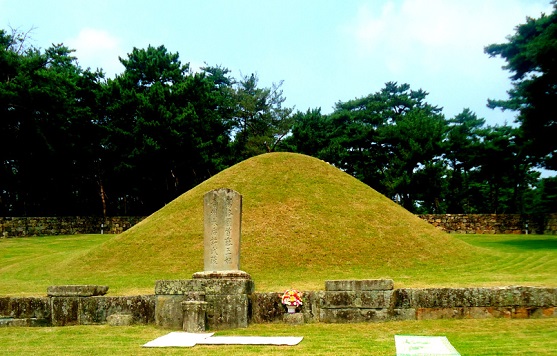
Tomb (in South Korea) of Suriratna, the Princess of the Indian kingdom Ayuta (Ayodhya) and queen of Gaya (in South Korea). The stones used at the bottom, as well as the stone tablet, are distinctly Indian. They are said to have been taken from India to Korea by the queen herself. Photo: Animesh
1st century A.D. Ayodhya: the royal dream
In A.D. 48, in the month of May, the King of Kosal(a) (the present Ayodhya area of India) and his wife both had identical dreams in which Lord Sange Jae told them that Suro, the King-designate of the Geumgwan Gaya kingdom (in Korea) was single and was looking for a wife.
(Buddhism came to Korea in A.D. 372. Therefore, it is so heart-warming for Indians to note that a kingdom founded more than three hundred years before had the same name as the holiest Buddhist town in the world. Some scholars speculate, without providing evidence, that this was not a coincidence and that the Koreans had started going to India to study Buddhism much before Buddhism officially came to Korea.
(Kim Hae June, a lay scholar, feels, ‘Probably young man, whose [n]ame is “Kim suro” went to Ayodhia to study Buddism.’ [sic] Japanese mythology & folklore(The site Mall Stuffs writes, also without evidence, that ‘the princess came from the royal Gaya dynasty,’ giving the Korean kingdom the name of her ancestral land.)
Korean chronicles say that Lord Sange Jae told the king and queen of Ayuta, in identical dreams on the same night, that Kim Suro had been chosen to become the king of Gaya because he was a holy and saintly man. ‘In governing the new country he needs a queen consort,’ Lord Sange Jae said, ‘therefore, I urge you to send your princess to marry him.’
Sange/ Singhe/ Sengge Simha/ all mean the Lion God, which, Parvez Dewan argues, would mean Lord Nara Simha.
Ayodhya was the capital of the Kosala Kingdom.
Prof Kim Byung-mo of Korea asserts that Suri Ratna’s brothers later went on to become the Kings of Ayodhya. However, according to a Korean legend one of her brothers, who is known as Po-ok in Korean, accompanied her to Korea.
The last rulers of Ayodhya, before the British took over and abolished kings, were a Mishr[a] sub-caste of Pathak descent. This is one reason why the Karak clan of Korea believes that the king of Ayodhya in A.D. 48, too, would have been a Mishr. The double-fish insignia of the Mishr family is a more important reason.
The present descendants of the Mishr clan were somewhat overwhelmed by this greatness thrust on them. Modestly, they pointed out that their family, a Pathak clan from Bhojpur (Bihar), migrated to Ayodhya as recently as in the late 17th century, and that their lineage can be traced only up to the last ten generations.
The Karaks of Korea would have none of this rectitude. They insisted that the present Mishra family was their kin. Therefore, the Mishras reciprocated the love given to them by the Koreans.
Meanwhile in southern Korea…
Also around A.D. 48 an oracle asked the King-designate of Korea’s Gaya (or Kaya) kingdom to await the coming of a princess from ‘Ayuta.’
At the time, indeed ‘since creation itself,’ the Kimhae region, which is in the southern part of Korea, had never been welded together into one nation or kingdom. It was ruled by nine chieftains.
In A.D. 42, during the spring festival, a voice was heard from the sky. The divine voice, similar to the Hindu concept of âkâsh vâni (and similar Biblical divine voices), asked the people to go to the top of a mountain. There, wrapped in a red cloth, a golden bowl with six golden eggs came down from heaven. The next day, each egg hatched into a prince.
On the auspicious day full moon day (pûrnimâ to the Hindus), one of the boys was named Kim (gold), given the title Suro and proclaimed king. The other five children were made chiefs of the Gaya/ Kaya tribes that lived nearby.
In A.D. 42 King Kim Suro (or Sureung) founded a kingdom that he named Karak, with its capital in the present Gimhae city. To establish a city within months of his birth Suro must have been born fully formed. Apparently, in no time after his birth he grew to be nine feet tall. (According to less reliable sources, the Karak capital had been founded in 57 B.C. )
From Ayuta to Korea by ship
Back in Ayuta, the King asked his daughter Princess Suri Ratna (the ‘brown gemstone’ or ‘the auspicious gem’) to set sail for Korea. This would not have been easy because India’s Ayodhya is a thousand kilometres from the nearest seashore.
The wedding
The king gave Korean costumes to all members of Suri Ratna’s entourage to wear and embroidered quilts and pillows for the beds that they would sleep on.
The Samguk Yusa records that before her wedding rituals began, Suri Ratna went to the top of the hill that her tent was on, changed her lower garment, which was made of silk brocade, and gave the garment that she had removed as an offering to the mountain spirit. (In both India and Thailand the lower garment would have been an unstitched garment wrapped around the waist and touching the feet. The Samguk Yusa variously records that this garment was a skirt or pajamas, neither of which was unlikely in the 1st century A.D.
The blessings of a Buddhist pagoda built by Lord Buddha himself, thus, ensured that the predictions made to the families of Suri Ratna and Suro came true and King Kim Suro married the Indian princess.
During the celebrations Suri Ratna’s retinue was housed in a 20-room guest house.
On the wedding night, when the princess of Ayuta and the king of Gaya were finally together, she said to her husband, ‘I am the princess of Ayuta. My surname [in the Korean language] is Hurh [or Huh, Hso, Ho, Hur or Heo] and my given name is Hwang-ok [yellow jade].’
This would prove the princess’ Indian-origin because Suri Ratna means ‘the sun-like or golden gemstone’ and Sri Ratna ‘the auspicious gemstone.’ In both Sanskrit and Korean the princess’ name refers to a gem that is yellow or golden. Clearly, the Korean name that she adopted was a translation of her Sanskrit name—Indian or Thai (the Thais have wonderful and complex, literary Sanskrit names to this day, even as the Indians had abandoned Sanskrit names for several centuries).
The young bridge added, ‘I am 16’ [not 28, as recorded on some websites]. She also told her husband about the prophecy that brought her to Gaya.
Hwang-ok recounted the stormy sea journey, during which she found the Beonda peach, which was the sacred fruit of love.
King Suro replied, ‘My life has been uniquely spiritual from the day I was born. Therefore, I always knew of your coming from a distant land. Which is why I never considered marrying any of the noble ladies proposed by my courtiers. I am lucky that such a graceful princess is now my queen.’
Ratna is renowned in Korea as Queen Huh (or Hur, Ho, Hsu, Heo or Hurh) Hwang-ok (yellow jade). Hurh does sound like a Koreanisation of Mishr.
After the wedding
After the king and queen had been together for two nights and one day, some of the Queen's escorts decided to return home, King Suro gifted them 1,200 yards of hempen cloth and ten bags of rice each.
The royal couple entered the royal palace on the first day of the eighth month. They came in ornate palanquins, while the courtiers came in carriages and on horses. The gifts that Hwang-ok had brought from Ayuta followed in several wagons.
The queen began to live in the inner palace. The trousseau and valuable that she had brought from Ayuta were placed in a store, for her to use whenever she wanted.
Before their first child [Prince Kodung] was conceived, both king and queen had an identical dream in which they saw a bear. The queen conceived thereafter.
These facts have been recorded on four pages of the Garakguk-gi (A shronicle of the Karak or Garak kingdom) section of the voluminous Samguk Yusa ("The Heritage History of the Three Kingdoms"), written in the 1200s. These four pages are an account of the marriage of Kim Su-ro.
King Kim Suro founded the Gaya Kingdom (57 B.C./ A.D.42 – A.D. 668) in the southeastern part of the Korean Peninsula. Korea’s Gaya was where Gimhae/ Kimhae in the South Gyeongsang Province now is.
A short animated Korean version of the love story can be seen on youtube
Where was Queen Heo/ Huh’s Ayuta?
Samguk Yusa mentions that the princess was from a far-off kingdom called Ayuta (or Ajutuo) in the language of that country and Ch'un-ch'uk in Korean.
The Samguk Yusa was translated into English by Professor Ha Tae-Hung. Grafton K. Mintz (1925–1983), an American journalist who had settled in Korea, edited the translation. Mintz speculated that Ayuta (or Ajutuo) was the same as Thailand’s Ayutthaya. While Mintz’s reasoning is not known, Indian author Parvez Dewan feels that arguments in favour of Thailand’s Ayutthaya are:
i) There is a direct sea route between Thailand’s Ayutthaya and Korea; India’s Ayodhya is landlocked and about a thousand kilometres from the nearest seashore in the Bay of Bengal [Kalingodra, or the sea of Kalinga in Oriya] and about 1200 km from Nanigaina [Puri], the likely port in Kalinga [Ho-Ling, in Chinese];
ii) Suri Ratna is a very Malay-Thai-Balinese sounding name;
iii) Racially the Thais are closer to Korea.
However, Parvez Dewan points out, the Thai Ayutthaya was established in A.D. 1351, around a century after the 'Samguk Yusa’ was written. The chronicle makes it clear that it is referring to a very old event and from it the year A.D. 48 has been derived. In that year, indeed in that era, the Kingdom of Funan existed in Thailand. True, Funan was influenced by Indian culture but Thailand was more than thirteen hundred years away from setting up an Ayodhya.
In A.D. 48 the only Ayodhya was in India. The Koreans, especially the Karaks, universally accept the Indian Ayodhya as the land of Princess Suri Ratna. Therefore, the matter should rest there.
The government of South Korea, too, accepts the Indian Ayodhya as the land that Hwang-ok came from. When Mr. Lee Myung-bak was President of South Korea a press release from his office said that his wife ‘Kim [was] a descendant of Heo Hwang-ok, a princess who travelled from an ancient Kingdom in Ayodhya, India , to Korea.’
As official as that.
In March 1999, Prime Minister Kim Jong-pil invited the present scions of the Mishra dynasty of Ayodhya to a memorial ceremony for King Kim Suro held that year. That the insignia of the Mishra rulers contained two fishes has convinced the Karak clan of Korea that the Mishras are the descendants of those who ruled Ayodhya in A.D. 48.
The Karak clan
Heo Hwang-ok was the first queen of Geumgwan Gaya, and the ancestor of several Korean sub-clans.
The Karak clan of South Korea traces its ancestry to Hwang-ok (Suri Ratna) and are her descendants. Kim Suro and Heo/ Hurh started the Karak clan in A.D. 48. The Indo-Korean royal couple had ten sons and two daughters.
After the birth of the tenth child, Queen Hwang-ok told her husband, ‘I left the land of my ancestors for Gaya in order to fulfil the divine prophecy and serve you. However, it saddens me to think that the [sur]name of my family, Hurh [or Heo or Huh or Hoon etc.] will not be inherited by any of our children.’
Incidentally, Mishr and Hoon are both Brahmin castes of India.
The king was moved by the sadness of his queen at the thought of her noble surname vanishing with him. So, according to the text on Queen Hwang-ok’s tomb, the king chose two of the sons, including the eldest, Kŏdǔng, to adopt their mother's family name, as translated into Korean: Huh/ Hoon/ Hurh.
The Kim clan of Gimhae are descendants of the other eight sons.
Kim means ‘gold’ in Korean. So does ‘suri’ (sun-like) in Sanskrit.
However, some genealogies say that the king made five, i.e. one half, of his sons use their mother’s surname. Indeed, there are five branches of the Hurh clan: Kimhae (or Gimhae), Hayang, Taein, Hansan and Yangcheon/ Gongam. The Kim clan of Gimhae, too, are descendants of Queen Hwang-ok and King Suro
Of the two daughters, one married a Talhae and the other a Silla, both being noble clans. (By A.D. 512 the Sillas would conquer all of Gaya/ Kaya.) According to one account, all nine sons other than Kŏdǔng became monks
The First Lady of S. Korea Mrs. Kim Yoon-ok; former President Kim Dae-jung; former President Kim Young-sam and former Prime Minister Kim Jong-pil belong to this clan. Uk Heo who co-authored South Korea's Rise: Economic Development, Power and Foreign Relations (Cambridge University Press), too, is a descendant.
Indeed, almost all Koreans with the surnames Kim and Huh/ Hoon/ Heo from Gimhae and Lee from Incheon belong to the Karak clan and are descendants of Suri Ratna. This clan of more than 60 lakh (6 million) people accounts for more than a tenth of Korea’s population of 5 crore (50 million) in 2014.
In 2012 when the then Indian Prime Minister Manmohan Singh visited South Korea, his wife Gursharan Kaur asked Indian Ambassador Vishnu Prakash how many Indians lived in Korea. Prakash assumed that Mrs Kaur meant PIOs/ OCIs and NRIs. So, he said that there was a community of about seven to eight thousand Indians. But Korean President Lee Myung-Bak's wife, Kim Yoon-ok, corrected him by saying he was ill-informed and the number was 5 million (50 lakh) and that she (Kim Yoon-ok) herself was one of them.
In India it is a matter of great happiness that the Indians and more than 10% of Koreans share the same blood and genes--and that the Indians and all Koreans share the same liberal democratic values. And also the same views on marrying within what Indians call gotr and the Koreans call pon.
Till the early 1900s people with the pon Kimhae Kim and the pon Kimhae Heo did not inter-marry, as is the Indo-Korean tradition of not marrying within the clan (gotr). To inter-marry is almost like committing incest. As recently as in 1961, archaeologist-ethnographer Kim Byung-mo started dating a college student Ho Mi-kyong in 1961. However, each had a different song, therefore, they could go ahead. [Kim Byung-mo later became Professor Emeritus of Hanyang University and is considered a national archaeologist in Korea.]
Kim Byung-mo would attribute the darkness of his skin to his Indian genes. Mall Stuffs gives us the following nugget about the Kims: ‘Their nose is less flat compared to other Koreans who came from Japan and China.’
From comments on social media by a Kim now settled in the USA it is seen that not only do some Kims feel different, some also feel inferior. In 2013 Kim Hae June wrote on Japanese mythology & folklore, ‘Our family are [sic] different from other Korean member. We thought that fact was bad, inferior and cursed.’ In another post he reiterated, ‘We are different from the most community folk.’ [sic]
And this despite the community’s prosperity and its having produced top national leaders, corporate chiefs, scholars and actors. Kim Young-hee, the mother of international rap star PSY, is a Kim.
Mall Stuffs informs us that ‘As a result [of this matrimonial relationship between India and Korea], Korean vocabulary absorbed many Sanskrit concepts and words like 'Narak'(Hell), 'Stupa'(Statue), 'Brahma'(deity of creation), 'Indra'(deity of heaven), 'Bhikuni' 'Nidana' etc.’
Monuments…
…in Ayodhya
On the 6th March 2001 the Karak Clan Society built a monument at Ayodhya on the west bank of River Saryu, in cooperation with the state government of Uttar Pradesh. The North Korean ambassador to India was among those present. Since then members of the Karak Clan Society, and often Government officials from Gimhae City (South Korea), have visited the site every March to celebrate the Queen’s anniversary. Often a traditional Korean dancing team has participated in the ceremony.
In May 2001 the Mayors of Kim-Hae and Ayodhya signed a Sister City Bond. BM Kim, of King Suro’s clan, granted Rs.2 billion to renovate and improve the infrastructure of Ayodhya and also build the monument dedicated to Hwang-ok that was the constructed on the banks of River Saryu.
Mall Stuffs writes: ‘To build this monument, special three [metre] high stone, weighing 7,500 kg, were [was?] shipped from South Korea and expert Korean technician and architects were summoned to construct the monument in traditional Korean style.’
In 2014 the editor of this article visited Korea. As the Secretary of India’s Ministry of Tourism he gave the government of Uttar Pradesh a grant of just under Rs.5 crore [50 million], with the request to build a Korean-style monument within the same site in order to strengthen India’s ties with S. Korea and give the Karak Clan a sense of belonging in Ayodhya.
…in Korea
Queen Huh's tomb located in Gimhae, South Korea, has an Indian-style stupa (pagoda) in front, built with stones that the queen is believed to have brought from Ayodhya. Indeed, during the sea journey when the sea got very stormy, the princess’ servants arranged the stones into a pagoda to propitiate the god of the ocean. (Others say that Suri Ratna’s father had got the stone stupa/ pagoda placed on the boat to serve as ballast and keep the ship from tumbling over of the sea got too rough.)
Indeed, the architecture of the pagoda is very different from contemporary Korean pagodas and lacks their finesse. The stones are very Indian-looking. Koreans find these rough but very durable brown rocks ‘strange;’ Indians, on the other hand, are reminded of temples at home.
Song Weon Young, city archaeologist of Kimhae told India’s NDTV, “This stone is only found in India.”
The Samguk Yusa also informs us that King Jilji built the temple, called Wanghusa ("the temple of the Queen") in A.D. 452, to honour the memory of Queen Hwang-ok. Buddhism had not reached Korea by then.
The mystery of the twin-fishes
The gate of King Suro’s tomb has two fish carved in the centre. It has stone sculptures of a warrior, a literary man [typical Hindu caste prototypes], a horse, a sheep and a tiger.
Twin-fishes (ssang-o) have been engraved on the tomb’s gate. The Korean managers of the tomb do not know what these fish signify, apart from being ssang-o sin (the twin-fish deity). Therefore, Korean scholar Kim Byung-mo travelled though India and Pakistan to trace the roots and meaning of the symbol.
Efforts by Indian envoys
India’s Ambassador to S. Korea (2005 and 2008), N. Parthasarathi, first heard the story when President Roh Moo-hyun visited India in 2004.
This led to extensive research and a voyage of discovery, which he distilled into the novel Silk and Empress/ The Legend of Ayodhya Princess in Korea."Ambassador Vishnu Prakash told the editor of this article about Princess Suri Ratna. That led to my conceptualising a grand memorial in Ayodhya and sanctioning almost Rs5 crore [50 million] for it in my capacity as the Secretary of India’s Ministry of Tourism.
Readers with any extra information about this subject may please send the details to us at Facebook
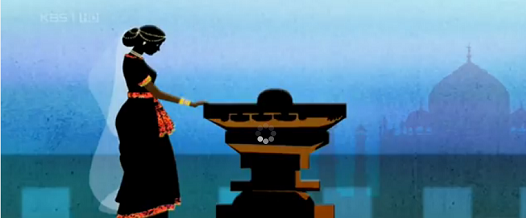
Kosal/ Ayodhya: Princess Suriratna offers prayers. (Animation by: SNSD TV )

Some Indian coast: Princess Suriratna enters the boat bound for Korea. Her entourage includes camels, c. A.D. 48. (Animation by S.Korea’s SNSD TV)

The boat to Korea sails through the monsoon rains. That it had red sails and a red flag has been mentioned in Korean chronicles. Animation by: SNSD TV

Gaya, Korea: The Indian princess meets the King of Gaya. King Suro tells Suri Ratna that he knew that she would sail across the seas to marry him, because of which he did not marry any of the noble ladies who had been suggested to him.Animation by: SNSD TV
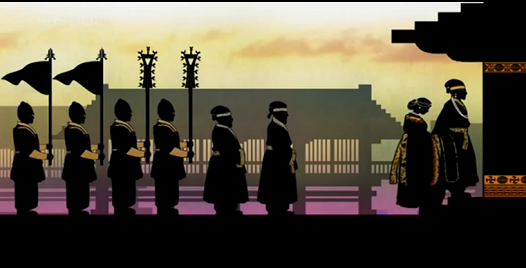
The newly-wed couple enters the royal palace in Gaya (Korea). Animation by: SNSD TV
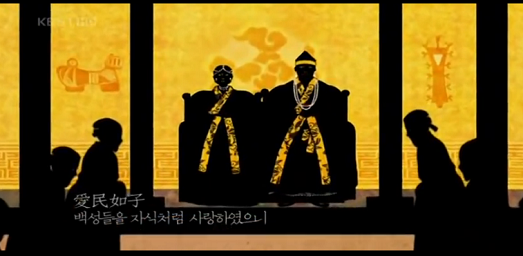
They rule the kingdom of Gaya and live happily ever after. Animation by: SNSD TV

King Suro. Animation by: SNSD TV
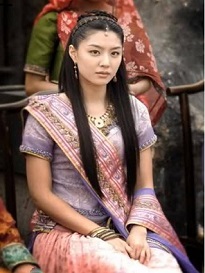
A Korean actress playing Hwang-ok. Mall Stuffs

Capt. Ajit Vadakayil’s blog THE KOREAN BRAHMINS,

Clinching evidence: The logo of the Government of Uttar Pradesh, the state where Ayodhya is. Even the type of fish and their dimensions remain the same. The only thing that has changed since A.D. 48 is the arrangement of the two fish.
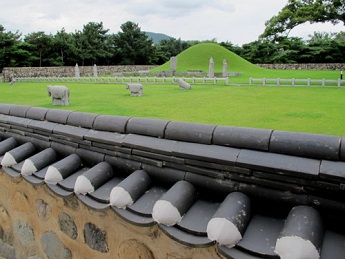
Hwang-ok’s tomb. Photo courtesy: The Soul of Seoul
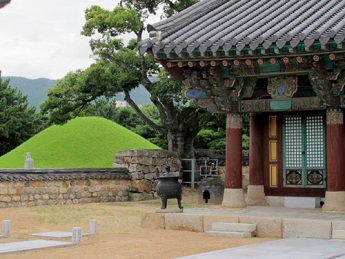
Hwang-ok’s tomb. Photo courtesy: The Soul of Seoul
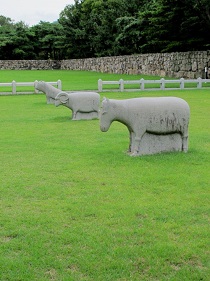
Hwang-ok’s tomb. Photo courtesy:The Soul of Seoul
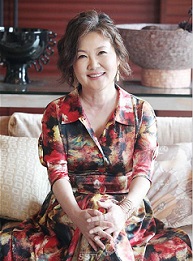
Actress Kim Hae Sook, 77th descendant of King Suro Dynasty
PSY, the most famous rapper, whose YouTube video crossed 1.8 billion views, is the son of Park WonHo, chairman of DI Corporation. His mother, "Kim Younghee", who owns several restaurants in
Gangnam, is the descendant of king suro and princess ‘Heo Hwangok’
Pay a visit to the picturesque banks of river Saryu in the holy city. Here one will find a monument in memory of an Ayodhya princess who is believed to have 'mothered' a dynasty in South Korea".
That there was a link between India and Korea after the advent of Buddhism is an established fact. However, links with the Far East are mentioned in Valmiki Ramayana too, which refers to the huge land mass of 'Shalmali Dvipa' which is the present day Australia and the smaller islands around it.
One of the 'vanara' brigade is known to have travelled on the sea-route from India via Shalmali-Dvipa and the neighboring countries to Peru in search of Sita.
There is a lot more research happening in Korea on this issue and we are bound to hear about the same in due course from Korean sources.
There is one additional point from Indian sources which say that the worship of the Vedic Goddess 'Gauri' was prevalent both in China and Korea. That there is truth to this argument is confirmed by this report of China Digital Times where they quote an Indian researcher Ananth Krishnan . He says that there is a forgotten history behind Hindu temples in Chedian village of Quanzhou where residents pray before a 'cross-legged' 'four-armed goddess' with a 'demon lying at her feet' but she is not a Chinese goddess.
Ananth Krishnan explains that while scholars remain uncertain about her identity, they do know that the shrine’s roots are Indian and that the history of these temples and their Tamil links were 'largely forgotten until the 1930s'.
“This is possibly the only temple in China where we are still praying to a Hindu God, even though most of the villagers still think she is Guanyin!” adds Li San Long, a Chedian resident.
The name 'Guanyin' is the distortion of the Indian Goddess 'Gauri' which is another name of both Parvati and Durga. It is said that it is from 'Gauri' that Korea gets its name via 'Gauraiya' and 'Guanyin'. Goddess Guanyin is also known as 'Kwan Yin'.

Goddess Guanyin is often depicted as
a many armed-goddess like the Vedic godddess
who entered Korean culture via China
Korean relative of Kings of Ayodhya goes on evidence hunting
Lucknow, Thu Jan 21 2010, 04:25 hrs

Tomb (in South Korea) of Suriratna, the Princess of the Indian kingdom Ayuta (Ayodhya) and queen of Gaya (in South Korea). The stones used at the bottom, as well as the stone tablet, are distinctly Indian. They are said to have been taken from India to Korea by the queen herself. Photo: Animesh
1st century A.D. Ayodhya: the royal dream
In A.D. 48, in the month of May, the King of Kosal(a) (the present Ayodhya area of India) and his wife both had identical dreams in which Lord Sange Jae told them that Suro, the King-designate of the Geumgwan Gaya kingdom (in Korea) was single and was looking for a wife.
(Buddhism came to Korea in A.D. 372. Therefore, it is so heart-warming for Indians to note that a kingdom founded more than three hundred years before had the same name as the holiest Buddhist town in the world. Some scholars speculate, without providing evidence, that this was not a coincidence and that the Koreans had started going to India to study Buddhism much before Buddhism officially came to Korea.
(Kim Hae June, a lay scholar, feels, ‘Probably young man, whose [n]ame is “Kim suro” went to Ayodhia to study Buddism.’ [sic] Japanese mythology & folklore(The site Mall Stuffs writes, also without evidence, that ‘the princess came from the royal Gaya dynasty,’ giving the Korean kingdom the name of her ancestral land.)
Korean chronicles say that Lord Sange Jae told the king and queen of Ayuta, in identical dreams on the same night, that Kim Suro had been chosen to become the king of Gaya because he was a holy and saintly man. ‘In governing the new country he needs a queen consort,’ Lord Sange Jae said, ‘therefore, I urge you to send your princess to marry him.’
Sange/ Singhe/ Sengge Simha/ all mean the Lion God, which, Parvez Dewan argues, would mean Lord Nara Simha.
Ayodhya was the capital of the Kosala Kingdom.
Prof Kim Byung-mo of Korea asserts that Suri Ratna’s brothers later went on to become the Kings of Ayodhya. However, according to a Korean legend one of her brothers, who is known as Po-ok in Korean, accompanied her to Korea.
The last rulers of Ayodhya, before the British took over and abolished kings, were a Mishr[a] sub-caste of Pathak descent. This is one reason why the Karak clan of Korea believes that the king of Ayodhya in A.D. 48, too, would have been a Mishr. The double-fish insignia of the Mishr family is a more important reason.
The present descendants of the Mishr clan were somewhat overwhelmed by this greatness thrust on them. Modestly, they pointed out that their family, a Pathak clan from Bhojpur (Bihar), migrated to Ayodhya as recently as in the late 17th century, and that their lineage can be traced only up to the last ten generations.
The Karaks of Korea would have none of this rectitude. They insisted that the present Mishra family was their kin. Therefore, the Mishras reciprocated the love given to them by the Koreans.
Meanwhile in southern Korea…
Also around A.D. 48 an oracle asked the King-designate of Korea’s Gaya (or Kaya) kingdom to await the coming of a princess from ‘Ayuta.’
At the time, indeed ‘since creation itself,’ the Kimhae region, which is in the southern part of Korea, had never been welded together into one nation or kingdom. It was ruled by nine chieftains.
In A.D. 42, during the spring festival, a voice was heard from the sky. The divine voice, similar to the Hindu concept of âkâsh vâni (and similar Biblical divine voices), asked the people to go to the top of a mountain. There, wrapped in a red cloth, a golden bowl with six golden eggs came down from heaven. The next day, each egg hatched into a prince.
On the auspicious day full moon day (pûrnimâ to the Hindus), one of the boys was named Kim (gold), given the title Suro and proclaimed king. The other five children were made chiefs of the Gaya/ Kaya tribes that lived nearby.
In A.D. 42 King Kim Suro (or Sureung) founded a kingdom that he named Karak, with its capital in the present Gimhae city. To establish a city within months of his birth Suro must have been born fully formed. Apparently, in no time after his birth he grew to be nine feet tall. (According to less reliable sources, the Karak capital had been founded in 57 B.C. )
From Ayuta to Korea by ship
Back in Ayuta, the King asked his daughter Princess Suri Ratna (the ‘brown gemstone’ or ‘the auspicious gem’) to set sail for Korea. This would not have been easy because India’s Ayodhya is a thousand kilometres from the nearest seashore.
So, the King of Ayuta sent a retinue of some nobles and twenty servants, all of them (according to Korean hostories) seven feet tall, to accompany his daughter. As gifts for the Korean king he sent gold, jewels, silk brocade, silver, tableware and, in most versions, a tea plant. (Later, she planted the tea sapling in Korea, which resulted in Korea’s first tea garden and led to the practice of tea cultivation in Korea.
The journey by sea took three months. The boat had red sails and a red flag, Korean chronicles inform us. (The bowl containing the egg that the king was born from had also been wrapped in red cloth.) During the sea voyage, by when Suri Ratna had been sailing for two months, she came upon the Beondo tree, which bore fruit—a peach called Beondo—only once in 3000 years. The princess and her companions ate steamed dates of the sea and peaches during their journey.
The Indian princess Suri [Sri] Ratna reached Korea on 27 July, 48 A.D. Korean chronicles quote her as telling her husband that she was 16 [not 28, as recorded by some]. Therefore, she must have been born in A.D. 32. (She died in A.D. 189, at age 157. The king died a year later.)
Suri Ratna lands in Korea
A rival Korean king and ‘other whimsical elements’ in the Korean court tried their best to prevent the divinely ordained couple from marrying. The courtiers wanted the king to marry one of ladies shortlisted by them instead. Suro, on the other hand, knew that God had chosen a queen for him. He told the chiefs, ‘I was born from heaven. Therefore, let heaven decide my marriage.’
One day, acting on mystical premonition, the king asked Yuch'ŏn-gan to go to the southern island of Mangsan-do, first by horse and then by boat. While they were on the shores of the island, Yuch'ŏn-gan and his sailors from Gaya saw a boat with red sails. Yuch'ŏn-gan guided the boat to the shore.
When the boat reached the shores, Sin'gwigan, an official, mounted a horse and rushed to tell the King that the boat had arrived. Suro was delighted. He asked the aforesaid heads of the nine main clans to receive the guests from Ayuta and bring them to his palace.
However, the chaste Princess Suri Ratna refused to be escorted by people whom she did not know. Besides, she said, it would be unbecoming for her to enter the palace without the appropriate rituals.
The king admired the princess’ chaste insistence and propriety. He got a tent pitched half way up a hill close to his own palace. That is where the princess stayed. Among the nobles and servants in her retinue were Sin Po/ Sinbo and his wife Mojong, and Cho Kuang/ Chongwang and his wife Moryang/ Morang. [Later, these two couples stayed on in Gaya and King Suro allotted them a house each, to help them settle down. Sin Po is probably the same as Po-ok, the brother of Suri Ratna.]
(Several years later the king constructed a grand temple at the place where he first met the princess. This is the pisa stone pagoda in front of Hwang-ok’s tomb in Kimhae. It is called Chimpungtap or the Wind-Calming Pagoda because the stones it has been built of had calmed the angry seas.)
(Ambassador N. Parthasarathi’s studies indicate that monk Jangyoohwasang was the brother of princess Heo; and that King Su-ro got constructed the Chilbul Temple, or “The Temple of the Seven Buddhas,” to commemorate seven Korean Buddhist monks attaining Nirvan. This could be another name for Po-ok, or another brother altogether.)
The journey by sea took three months. The boat had red sails and a red flag, Korean chronicles inform us. (The bowl containing the egg that the king was born from had also been wrapped in red cloth.) During the sea voyage, by when Suri Ratna had been sailing for two months, she came upon the Beondo tree, which bore fruit—a peach called Beondo—only once in 3000 years. The princess and her companions ate steamed dates of the sea and peaches during their journey.
The Indian princess Suri [Sri] Ratna reached Korea on 27 July, 48 A.D. Korean chronicles quote her as telling her husband that she was 16 [not 28, as recorded by some]. Therefore, she must have been born in A.D. 32. (She died in A.D. 189, at age 157. The king died a year later.)
Suri Ratna lands in Korea
A rival Korean king and ‘other whimsical elements’ in the Korean court tried their best to prevent the divinely ordained couple from marrying. The courtiers wanted the king to marry one of ladies shortlisted by them instead. Suro, on the other hand, knew that God had chosen a queen for him. He told the chiefs, ‘I was born from heaven. Therefore, let heaven decide my marriage.’
One day, acting on mystical premonition, the king asked Yuch'ŏn-gan to go to the southern island of Mangsan-do, first by horse and then by boat. While they were on the shores of the island, Yuch'ŏn-gan and his sailors from Gaya saw a boat with red sails. Yuch'ŏn-gan guided the boat to the shore.
When the boat reached the shores, Sin'gwigan, an official, mounted a horse and rushed to tell the King that the boat had arrived. Suro was delighted. He asked the aforesaid heads of the nine main clans to receive the guests from Ayuta and bring them to his palace.
However, the chaste Princess Suri Ratna refused to be escorted by people whom she did not know. Besides, she said, it would be unbecoming for her to enter the palace without the appropriate rituals.
The king admired the princess’ chaste insistence and propriety. He got a tent pitched half way up a hill close to his own palace. That is where the princess stayed. Among the nobles and servants in her retinue were Sin Po/ Sinbo and his wife Mojong, and Cho Kuang/ Chongwang and his wife Moryang/ Morang. [Later, these two couples stayed on in Gaya and King Suro allotted them a house each, to help them settle down. Sin Po is probably the same as Po-ok, the brother of Suri Ratna.]
(Several years later the king constructed a grand temple at the place where he first met the princess. This is the pisa stone pagoda in front of Hwang-ok’s tomb in Kimhae. It is called Chimpungtap or the Wind-Calming Pagoda because the stones it has been built of had calmed the angry seas.)
(Ambassador N. Parthasarathi’s studies indicate that monk Jangyoohwasang was the brother of princess Heo; and that King Su-ro got constructed the Chilbul Temple, or “The Temple of the Seven Buddhas,” to commemorate seven Korean Buddhist monks attaining Nirvan. This could be another name for Po-ok, or another brother altogether.)
The wedding
The king gave Korean costumes to all members of Suri Ratna’s entourage to wear and embroidered quilts and pillows for the beds that they would sleep on.
The Samguk Yusa records that before her wedding rituals began, Suri Ratna went to the top of the hill that her tent was on, changed her lower garment, which was made of silk brocade, and gave the garment that she had removed as an offering to the mountain spirit. (In both India and Thailand the lower garment would have been an unstitched garment wrapped around the waist and touching the feet. The Samguk Yusa variously records that this garment was a skirt or pajamas, neither of which was unlikely in the 1st century A.D.
The blessings of a Buddhist pagoda built by Lord Buddha himself, thus, ensured that the predictions made to the families of Suri Ratna and Suro came true and King Kim Suro married the Indian princess.
During the celebrations Suri Ratna’s retinue was housed in a 20-room guest house.
On the wedding night, when the princess of Ayuta and the king of Gaya were finally together, she said to her husband, ‘I am the princess of Ayuta. My surname [in the Korean language] is Hurh [or Huh, Hso, Ho, Hur or Heo] and my given name is Hwang-ok [yellow jade].’
This would prove the princess’ Indian-origin because Suri Ratna means ‘the sun-like or golden gemstone’ and Sri Ratna ‘the auspicious gemstone.’ In both Sanskrit and Korean the princess’ name refers to a gem that is yellow or golden. Clearly, the Korean name that she adopted was a translation of her Sanskrit name—Indian or Thai (the Thais have wonderful and complex, literary Sanskrit names to this day, even as the Indians had abandoned Sanskrit names for several centuries).
The young bridge added, ‘I am 16’ [not 28, as recorded on some websites]. She also told her husband about the prophecy that brought her to Gaya.
Hwang-ok recounted the stormy sea journey, during which she found the Beonda peach, which was the sacred fruit of love.
King Suro replied, ‘My life has been uniquely spiritual from the day I was born. Therefore, I always knew of your coming from a distant land. Which is why I never considered marrying any of the noble ladies proposed by my courtiers. I am lucky that such a graceful princess is now my queen.’
Ratna is renowned in Korea as Queen Huh (or Hur, Ho, Hsu, Heo or Hurh) Hwang-ok (yellow jade). Hurh does sound like a Koreanisation of Mishr.
After the wedding
After the king and queen had been together for two nights and one day, some of the Queen's escorts decided to return home, King Suro gifted them 1,200 yards of hempen cloth and ten bags of rice each.
The royal couple entered the royal palace on the first day of the eighth month. They came in ornate palanquins, while the courtiers came in carriages and on horses. The gifts that Hwang-ok had brought from Ayuta followed in several wagons.
The queen began to live in the inner palace. The trousseau and valuable that she had brought from Ayuta were placed in a store, for her to use whenever she wanted.
Before their first child [Prince Kodung] was conceived, both king and queen had an identical dream in which they saw a bear. The queen conceived thereafter.
These facts have been recorded on four pages of the Garakguk-gi (A shronicle of the Karak or Garak kingdom) section of the voluminous Samguk Yusa ("The Heritage History of the Three Kingdoms"), written in the 1200s. These four pages are an account of the marriage of Kim Su-ro.
King Kim Suro founded the Gaya Kingdom (57 B.C./ A.D.42 – A.D. 668) in the southeastern part of the Korean Peninsula. Korea’s Gaya was where Gimhae/ Kimhae in the South Gyeongsang Province now is.
A short animated Korean version of the love story can be seen on youtube
Where was Queen Heo/ Huh’s Ayuta?
Samguk Yusa mentions that the princess was from a far-off kingdom called Ayuta (or Ajutuo) in the language of that country and Ch'un-ch'uk in Korean.
The Samguk Yusa was translated into English by Professor Ha Tae-Hung. Grafton K. Mintz (1925–1983), an American journalist who had settled in Korea, edited the translation. Mintz speculated that Ayuta (or Ajutuo) was the same as Thailand’s Ayutthaya. While Mintz’s reasoning is not known, Indian author Parvez Dewan feels that arguments in favour of Thailand’s Ayutthaya are:
i) There is a direct sea route between Thailand’s Ayutthaya and Korea; India’s Ayodhya is landlocked and about a thousand kilometres from the nearest seashore in the Bay of Bengal [Kalingodra, or the sea of Kalinga in Oriya] and about 1200 km from Nanigaina [Puri], the likely port in Kalinga [Ho-Ling, in Chinese];
ii) Suri Ratna is a very Malay-Thai-Balinese sounding name;
iii) Racially the Thais are closer to Korea.
However, Parvez Dewan points out, the Thai Ayutthaya was established in A.D. 1351, around a century after the 'Samguk Yusa’ was written. The chronicle makes it clear that it is referring to a very old event and from it the year A.D. 48 has been derived. In that year, indeed in that era, the Kingdom of Funan existed in Thailand. True, Funan was influenced by Indian culture but Thailand was more than thirteen hundred years away from setting up an Ayodhya.
In A.D. 48 the only Ayodhya was in India. The Koreans, especially the Karaks, universally accept the Indian Ayodhya as the land of Princess Suri Ratna. Therefore, the matter should rest there.
The government of South Korea, too, accepts the Indian Ayodhya as the land that Hwang-ok came from. When Mr. Lee Myung-bak was President of South Korea a press release from his office said that his wife ‘Kim [was] a descendant of Heo Hwang-ok, a princess who travelled from an ancient Kingdom in Ayodhya, India , to Korea.’
As official as that.
In March 1999, Prime Minister Kim Jong-pil invited the present scions of the Mishra dynasty of Ayodhya to a memorial ceremony for King Kim Suro held that year. That the insignia of the Mishra rulers contained two fishes has convinced the Karak clan of Korea that the Mishras are the descendants of those who ruled Ayodhya in A.D. 48.
The Karak clan
Heo Hwang-ok was the first queen of Geumgwan Gaya, and the ancestor of several Korean sub-clans.
The Karak clan of South Korea traces its ancestry to Hwang-ok (Suri Ratna) and are her descendants. Kim Suro and Heo/ Hurh started the Karak clan in A.D. 48. The Indo-Korean royal couple had ten sons and two daughters.
After the birth of the tenth child, Queen Hwang-ok told her husband, ‘I left the land of my ancestors for Gaya in order to fulfil the divine prophecy and serve you. However, it saddens me to think that the [sur]name of my family, Hurh [or Heo or Huh or Hoon etc.] will not be inherited by any of our children.’
Incidentally, Mishr and Hoon are both Brahmin castes of India.
The king was moved by the sadness of his queen at the thought of her noble surname vanishing with him. So, according to the text on Queen Hwang-ok’s tomb, the king chose two of the sons, including the eldest, Kŏdǔng, to adopt their mother's family name, as translated into Korean: Huh/ Hoon/ Hurh.
The Kim clan of Gimhae are descendants of the other eight sons.
Kim means ‘gold’ in Korean. So does ‘suri’ (sun-like) in Sanskrit.
However, some genealogies say that the king made five, i.e. one half, of his sons use their mother’s surname. Indeed, there are five branches of the Hurh clan: Kimhae (or Gimhae), Hayang, Taein, Hansan and Yangcheon/ Gongam. The Kim clan of Gimhae, too, are descendants of Queen Hwang-ok and King Suro
Of the two daughters, one married a Talhae and the other a Silla, both being noble clans. (By A.D. 512 the Sillas would conquer all of Gaya/ Kaya.) According to one account, all nine sons other than Kŏdǔng became monks
The First Lady of S. Korea Mrs. Kim Yoon-ok; former President Kim Dae-jung; former President Kim Young-sam and former Prime Minister Kim Jong-pil belong to this clan. Uk Heo who co-authored South Korea's Rise: Economic Development, Power and Foreign Relations (Cambridge University Press), too, is a descendant.
Indeed, almost all Koreans with the surnames Kim and Huh/ Hoon/ Heo from Gimhae and Lee from Incheon belong to the Karak clan and are descendants of Suri Ratna. This clan of more than 60 lakh (6 million) people accounts for more than a tenth of Korea’s population of 5 crore (50 million) in 2014.
In 2012 when the then Indian Prime Minister Manmohan Singh visited South Korea, his wife Gursharan Kaur asked Indian Ambassador Vishnu Prakash how many Indians lived in Korea. Prakash assumed that Mrs Kaur meant PIOs/ OCIs and NRIs. So, he said that there was a community of about seven to eight thousand Indians. But Korean President Lee Myung-Bak's wife, Kim Yoon-ok, corrected him by saying he was ill-informed and the number was 5 million (50 lakh) and that she (Kim Yoon-ok) herself was one of them.
In India it is a matter of great happiness that the Indians and more than 10% of Koreans share the same blood and genes--and that the Indians and all Koreans share the same liberal democratic values. And also the same views on marrying within what Indians call gotr and the Koreans call pon.
Till the early 1900s people with the pon Kimhae Kim and the pon Kimhae Heo did not inter-marry, as is the Indo-Korean tradition of not marrying within the clan (gotr). To inter-marry is almost like committing incest. As recently as in 1961, archaeologist-ethnographer Kim Byung-mo started dating a college student Ho Mi-kyong in 1961. However, each had a different song, therefore, they could go ahead. [Kim Byung-mo later became Professor Emeritus of Hanyang University and is considered a national archaeologist in Korea.]
Kim Byung-mo would attribute the darkness of his skin to his Indian genes. Mall Stuffs gives us the following nugget about the Kims: ‘Their nose is less flat compared to other Koreans who came from Japan and China.’
From comments on social media by a Kim now settled in the USA it is seen that not only do some Kims feel different, some also feel inferior. In 2013 Kim Hae June wrote on Japanese mythology & folklore, ‘Our family are [sic] different from other Korean member. We thought that fact was bad, inferior and cursed.’ In another post he reiterated, ‘We are different from the most community folk.’ [sic]
And this despite the community’s prosperity and its having produced top national leaders, corporate chiefs, scholars and actors. Kim Young-hee, the mother of international rap star PSY, is a Kim.
Mall Stuffs informs us that ‘As a result [of this matrimonial relationship between India and Korea], Korean vocabulary absorbed many Sanskrit concepts and words like 'Narak'(Hell), 'Stupa'(Statue), 'Brahma'(deity of creation), 'Indra'(deity of heaven), 'Bhikuni' 'Nidana' etc.’
Monuments…
…in Ayodhya
On the 6th March 2001 the Karak Clan Society built a monument at Ayodhya on the west bank of River Saryu, in cooperation with the state government of Uttar Pradesh. The North Korean ambassador to India was among those present. Since then members of the Karak Clan Society, and often Government officials from Gimhae City (South Korea), have visited the site every March to celebrate the Queen’s anniversary. Often a traditional Korean dancing team has participated in the ceremony.
In May 2001 the Mayors of Kim-Hae and Ayodhya signed a Sister City Bond. BM Kim, of King Suro’s clan, granted Rs.2 billion to renovate and improve the infrastructure of Ayodhya and also build the monument dedicated to Hwang-ok that was the constructed on the banks of River Saryu.
Mall Stuffs writes: ‘To build this monument, special three [metre] high stone, weighing 7,500 kg, were [was?] shipped from South Korea and expert Korean technician and architects were summoned to construct the monument in traditional Korean style.’
In 2014 the editor of this article visited Korea. As the Secretary of India’s Ministry of Tourism he gave the government of Uttar Pradesh a grant of just under Rs.5 crore [50 million], with the request to build a Korean-style monument within the same site in order to strengthen India’s ties with S. Korea and give the Karak Clan a sense of belonging in Ayodhya.
…in Korea
Queen Huh's tomb located in Gimhae, South Korea, has an Indian-style stupa (pagoda) in front, built with stones that the queen is believed to have brought from Ayodhya. Indeed, during the sea journey when the sea got very stormy, the princess’ servants arranged the stones into a pagoda to propitiate the god of the ocean. (Others say that Suri Ratna’s father had got the stone stupa/ pagoda placed on the boat to serve as ballast and keep the ship from tumbling over of the sea got too rough.)
Indeed, the architecture of the pagoda is very different from contemporary Korean pagodas and lacks their finesse. The stones are very Indian-looking. Koreans find these rough but very durable brown rocks ‘strange;’ Indians, on the other hand, are reminded of temples at home.
Song Weon Young, city archaeologist of Kimhae told India’s NDTV, “This stone is only found in India.”
The Samguk Yusa also informs us that King Jilji built the temple, called Wanghusa ("the temple of the Queen") in A.D. 452, to honour the memory of Queen Hwang-ok. Buddhism had not reached Korea by then.
The mystery of the twin-fishes
The gate of King Suro’s tomb has two fish carved in the centre. It has stone sculptures of a warrior, a literary man [typical Hindu caste prototypes], a horse, a sheep and a tiger.
Twin-fishes (ssang-o) have been engraved on the tomb’s gate. The Korean managers of the tomb do not know what these fish signify, apart from being ssang-o sin (the twin-fish deity). Therefore, Korean scholar Kim Byung-mo travelled though India and Pakistan to trace the roots and meaning of the symbol.
At last in the Indian city of Ayodhya he found that almost all of that holy town’s hundreds of temples and countless ancient buildings of Ayodhya had the twin-fish motif, either painted or carved in stone.
Ayodhya is in the north Indian state of Uttar Pradesh. The twin fish motif is the state symbol of Uttar Pradesh.
However, “the same twin fish symbol can also be seen in ancient buildings in Nepal, Pakistan, China and Japan and the gate of royal tomb of King Suro in Kimhae city in Korea,” Prof Kim told India’s NDTV.
Nepal remains a Hindu country and Pakistan was carved out of a Hindu-majority country. China and Japan have honoured India by preserving aspects of Buddhist-Hindu culture that originated in India.
Ayodhya is in the north Indian state of Uttar Pradesh. The twin fish motif is the state symbol of Uttar Pradesh.
However, “the same twin fish symbol can also be seen in ancient buildings in Nepal, Pakistan, China and Japan and the gate of royal tomb of King Suro in Kimhae city in Korea,” Prof Kim told India’s NDTV.
Nepal remains a Hindu country and Pakistan was carved out of a Hindu-majority country. China and Japan have honoured India by preserving aspects of Buddhist-Hindu culture that originated in India.
Efforts by Indian envoys
India’s Ambassador to S. Korea (2005 and 2008), N. Parthasarathi, first heard the story when President Roh Moo-hyun visited India in 2004.
This led to extensive research and a voyage of discovery, which he distilled into the novel Silk and Empress/ The Legend of Ayodhya Princess in Korea."Ambassador Vishnu Prakash told the editor of this article about Princess Suri Ratna. That led to my conceptualising a grand memorial in Ayodhya and sanctioning almost Rs5 crore [50 million] for it in my capacity as the Secretary of India’s Ministry of Tourism.
Readers with any extra information about this subject may please send the details to us at Facebook

Kosal/ Ayodhya: Princess Suriratna offers prayers. (Animation by: SNSD TV )

Some Indian coast: Princess Suriratna enters the boat bound for Korea. Her entourage includes camels, c. A.D. 48. (Animation by S.Korea’s SNSD TV)

The boat to Korea sails through the monsoon rains. That it had red sails and a red flag has been mentioned in Korean chronicles. Animation by: SNSD TV

Gaya, Korea: The Indian princess meets the King of Gaya. King Suro tells Suri Ratna that he knew that she would sail across the seas to marry him, because of which he did not marry any of the noble ladies who had been suggested to him.Animation by: SNSD TV

The newly-wed couple enters the royal palace in Gaya (Korea). Animation by: SNSD TV

They rule the kingdom of Gaya and live happily ever after. Animation by: SNSD TV

King Suro. Animation by: SNSD TV

A Korean actress playing Hwang-ok. Mall Stuffs

Capt. Ajit Vadakayil’s blog THE KOREAN BRAHMINS,
KIM HEO CLAN carries several independently authenticated pictures of Hwang-ok’s tomb. His blog alone carries the above picture of a right-facing swastika. Is this swastika in the tomb? The blog does not say.

Clinching evidence: The logo of the Government of Uttar Pradesh, the state where Ayodhya is. Even the type of fish and their dimensions remain the same. The only thing that has changed since A.D. 48 is the arrangement of the two fish.

Hwang-ok’s tomb. Photo courtesy: The Soul of Seoul

Hwang-ok’s tomb. Photo courtesy: The Soul of Seoul

Hwang-ok’s tomb. Photo courtesy:The Soul of Seoul

Actress Kim Hae Sook, 77th descendant of King Suro Dynasty
Gangnam, is the descendant of king suro and princess ‘Heo Hwangok’
Mall Stuffs
Voices of Foreign Brides: The Roots and Development of Multiculturalism in Korea By Choong Soon Kim <>
Japanese Mythology & Folklore / Shivnath Thukral <>
Mall Stuffs
Hurh/ Heo Hwang-ok @ Suri Ratna
Edited and compiled by
Parvez Dewanhttp://indpaedia.com/ind/index.php/The_Karak_clan_of_Queen_Hwang-ok/_Suri_Ratna
Historical Evidences of ‘Heo Hwangok’ connection with India
One of the historical evidence is the story from "Sam Kuk Yusa", which I told above. Another Historical evidence is the document called “Record of a Journey to the Five Indian Kingdoms”. King Asoka (Descendant of lord Rama) transported 30,000 pound of gold and 57,000 pounds of yellow iron to king Chinhung of Korea to mould a beautiful image of Buddha.
Voices of Foreign Brides: The Roots and Development of Multiculturalism in Korea By Choong Soon Kim <>
Japanese Mythology & Folklore / Shivnath Thukral <>
Mall Stuffs
Hurh/ Heo Hwang-ok @ Suri Ratna
Edited and compiled by
Parvez Dewanhttp://indpaedia.com/ind/index.php/The_Karak_clan_of_Queen_Hwang-ok/_Suri_Ratna
Historical Evidences of ‘Heo Hwangok’ connection with India
One of the historical evidence is the story from "Sam Kuk Yusa", which I told above. Another Historical evidence is the document called “Record of a Journey to the Five Indian Kingdoms”. King Asoka (Descendant of lord Rama) transported 30,000 pound of gold and 57,000 pounds of yellow iron to king Chinhung of Korea to mould a beautiful image of Buddha.
This was the rise of Buddhism in Korea. King Asoka also sent Buddhist monk to Korea to spread the message of peace and nonviolence. Thus India first export to this island country (Where the sun rises first) was not tea, rice or coffee, but a whole cultural package including spirituality. As a result, Korean vocabulary absorbed many Sanskrit concepts and words like 'Narak'(Hell), 'Stupa'(Statue), 'Brahma'(deity of creation), 'Indra'(deity of heaven), 'Bhikuni' 'Nidana' etc.
Commenting on historical evidences, Former Korean ambassador Parthasarathi said “It was a time when gods used to appear and lots of things happened. What’s more important than what is reality is what could be.”
He also spoke of the monk Jangyoohwasang, the brother of princess Heo and the construction of the temple known as Chilbul Temple, or “The Temple of
the Seven Buddhas,” by King Suro to commemorate seven Korean Buddhist monk attaining Nirvana. He believed the Buddhism to Korea came from the princess Heo of Ayodhya, which was known as Great Gaya dynasty, after the enlightenment of Buddha. Buddhism was later elevated to a new level by mauryan king ‘Asoka the great’.
Genetic Evidences of ‘Heo Hwangok’ connection with India
According to genetic study done by Korean scientists, myth of the Indian princess marrying South Korean prince is certainly true. Genetic study of DNA samples from the site of two royal gaya tomb at Gimhae tomb, South Gyeongsang Province, reveals the genetic link between ethnic Korean and ethnic groups of Ayodhya. Their initial research was on focused on the mitochondrial DNA in the human remains.
Note: Mitochondria are cellular components that are the source of power for animal and human cells and have DNA which is passed to succeeding generations through the material line. This transmission makes such DNA valuable in studying family evolution
In 2010, National archaeologist and professor from Korea ‘Byung Mo Kim’ visited Ayodhya for the fifth time to gather more evidence. On being invited by state government Ayodhya Shodh Sansthan, He presented a slide where the historical evidences of cultural association between the countries were disclosed.
Though his slide, he exclaimed "The queen of Korea's biggest dynasty Hoh was the daughter of Ayodhya and in that manner, Ayodhya is like our mother city. Princess Ho travelled by sea route and married King Kim Suro of Kara dynasty. He was the first king and the entire Kara clan, which comprises over about twothird the population of Korea are its descendents," said Prof Kim.
The twin fish, which is the state symbol of Uttar Pradesh and is found on almost all the ancient buildings of Ayodhya, is the biggest clue to the link and the route undertaken by Princess Hoh, says the professor.
"I have pictorial evidences. Twin fish symbol can also be seen in ancient buildings in Nepal, Pakistan, China and Japan and the gate of royal tomb of King Suro in Kimhae city in Korea," said Prof Kim. "For the last 40 years, I have been tracing the route taken by the princess between Ayodhya and Kimhae city and after five visits; I have all the evidence to culturally connect the two cities.
Through these visits, we are making attempts to talk to the Uttar Pradesh government to open up their doors for strengthening cultural relations between the two countries," said Prof Kim.
The book ‘Sam Kuk Yusa’ says Princess set the trend of tea cultivation in Korea-she brought a pot of tea from Ayodhya which was cultivated to form a spiraling tea garden of Korea. This marked the trend of tea cultivation in Korea. She is said to have died at thegrand old age of 159.
The Ayodhya connection
That there was a link between India and Korea after the advent of Buddhism is an established fact. However, links with the Far East are mentioned in Valmiki Ramayana too, which refers to the huge land mass of 'Shalmali Dvipa' which is the present day Australia and the smaller islands around it.
One of the 'vanara' brigade is known to have travelled on the sea-route from India via Shalmali-Dvipa and the neighboring countries to Peru in search of Sita.
There is a lot more research happening in Korea on this issue and we are bound to hear about the same in due course from Korean sources.
There is one additional point from Indian sources which say that the worship of the Vedic Goddess 'Gauri' was prevalent both in China and Korea. That there is truth to this argument is confirmed by this report of China Digital Times where they quote an Indian researcher Ananth Krishnan . He says that there is a forgotten history behind Hindu temples in Chedian village of Quanzhou where residents pray before a 'cross-legged' 'four-armed goddess' with a 'demon lying at her feet' but she is not a Chinese goddess.
Ananth Krishnan explains that while scholars remain uncertain about her identity, they do know that the shrine’s roots are Indian and that the history of these temples and their Tamil links were 'largely forgotten until the 1930s'.
“This is possibly the only temple in China where we are still praying to a Hindu God, even though most of the villagers still think she is Guanyin!” adds Li San Long, a Chedian resident.
.jpg) |
| Goddess Guanyin |
The name 'Guanyin' is the distortion of the Indian Goddess 'Gauri' which is another name of both Parvati and Durga. It is said that it is from 'Gauri' that Korea gets its name via 'Gauraiya' and 'Guanyin'. Goddess Guanyin is also known as 'Kwan Yin'.

Goddess Guanyin is often depicted as
a many armed-goddess like the Vedic godddess
who entered Korean culture via China
Korean relative of Kings of Ayodhya goes on evidence hunting
Lucknow, Thu Jan 21 2010, 04:25 hrs
http://archive.indianexpress.com/news/korean-relative-of-kings-of-ayodhya-goes-on-evidence-hunting/569976/0
A Professor Emeritus of Hanyang University and national archeologist from Korea, Prof Byung Mo Kim shares a 'genetic connection' with Ayodhya.
"I share my genes with the royal family of Ayodhya. Travellers from both these countries not just traded goods, but also genes. And I hail from the Kara dynasty, whose first woman was the princess of Ayodhya, who married the first Kara king. Her brothers went on to become the Kings of Ayodhya and this is how I am genetically connected to the holy city," said Prof Kim.
The archaeologist, whose work on the princess of Ayodhya marrying the prince of Korea's Kara dynasty in 4th century AD has received widespread recognition, is on his fifth visit to the Holy city in search of more evidence for his study.
On his three-day visit to the state, he not only visited Ayodhya but also made a slide presentation on historical evidences of cultural links between Ayodhya and Korea, on being invited by the state government's Ayodhya Shodh Sansthan. "The queen of Korea's biggest dynasty Hoh was the daughter of Ayodhya and in that manner, Ayodhya is like our mother city. Princess Ho travelled by sea route and married King Kim Suro of Kara dynasty. He was the first king and the entire Kara clan, which comprises over about two-third the population of Korea are its descendents," said Prof Kim.
The twin fish, which is the state symbol of Uttar Pradesh and is found on almost all the ancient buildings of Ayodhya, is the biggest clue to the link and the route undertaken by Princess Hoh, says the professor. "I have pictorial evidences. The twin fish symbol is originally from the Meditarrenean states and it travelled to this part of the world and settled around Lucknow. But the same twin fish symbol can also be seen in ancient buildings in Nepal, Pakistan, China and Japan and the gate of royal tomb of King Suro in Kimhae city in Korea," said Prof Kim.
But, it is not this connection alone that has brought the archaeologist here as he also seeks a cultural connect between Ayodhya in Uttar Pradesh and Kimhae city in Korea.
"For the last 40 years, I have been tracing the route taken by the princess between Ayodhya and Kimhae city and after five visits, I have all the evidence to culturally connect the two cities."
Nearly six years ago, the Korean government had declared Ayodhya as the sister city of Korea and a monument in the memory of Princess Hoh was also established here in the city.
"The Kara clan is the biggest community in Korea and we like to visit our queen mother's place. Through these visits, we are making attempts to talk to the Uttar Pradesh government to open up their doors for strengthening cultural relations between the two countries," said Prof Kim.
Ayodhya Shodh Sansthan director Dr Y P Singh said the state's culture department is making all efforts to help the Koreans find their missing links.
"Through these interactions, we have been able to find new facets of Ayodhya and now in addition to being Lord Ram's birthplace, the city has another significance attached," said Singh.k
A Professor Emeritus of Hanyang University and national archeologist from Korea, Prof Byung Mo Kim shares a 'genetic connection' with Ayodhya.
"I share my genes with the royal family of Ayodhya. Travellers from both these countries not just traded goods, but also genes. And I hail from the Kara dynasty, whose first woman was the princess of Ayodhya, who married the first Kara king. Her brothers went on to become the Kings of Ayodhya and this is how I am genetically connected to the holy city," said Prof Kim.
The archaeologist, whose work on the princess of Ayodhya marrying the prince of Korea's Kara dynasty in 4th century AD has received widespread recognition, is on his fifth visit to the Holy city in search of more evidence for his study.
On his three-day visit to the state, he not only visited Ayodhya but also made a slide presentation on historical evidences of cultural links between Ayodhya and Korea, on being invited by the state government's Ayodhya Shodh Sansthan. "The queen of Korea's biggest dynasty Hoh was the daughter of Ayodhya and in that manner, Ayodhya is like our mother city. Princess Ho travelled by sea route and married King Kim Suro of Kara dynasty. He was the first king and the entire Kara clan, which comprises over about two-third the population of Korea are its descendents," said Prof Kim.
The twin fish, which is the state symbol of Uttar Pradesh and is found on almost all the ancient buildings of Ayodhya, is the biggest clue to the link and the route undertaken by Princess Hoh, says the professor. "I have pictorial evidences. The twin fish symbol is originally from the Meditarrenean states and it travelled to this part of the world and settled around Lucknow. But the same twin fish symbol can also be seen in ancient buildings in Nepal, Pakistan, China and Japan and the gate of royal tomb of King Suro in Kimhae city in Korea," said Prof Kim.
But, it is not this connection alone that has brought the archaeologist here as he also seeks a cultural connect between Ayodhya in Uttar Pradesh and Kimhae city in Korea.
"For the last 40 years, I have been tracing the route taken by the princess between Ayodhya and Kimhae city and after five visits, I have all the evidence to culturally connect the two cities."
Nearly six years ago, the Korean government had declared Ayodhya as the sister city of Korea and a monument in the memory of Princess Hoh was also established here in the city.
"The Kara clan is the biggest community in Korea and we like to visit our queen mother's place. Through these visits, we are making attempts to talk to the Uttar Pradesh government to open up their doors for strengthening cultural relations between the two countries," said Prof Kim.
Ayodhya Shodh Sansthan director Dr Y P Singh said the state's culture department is making all efforts to help the Koreans find their missing links.
"Through these interactions, we have been able to find new facets of Ayodhya and now in addition to being Lord Ram's birthplace, the city has another significance attached," said Singh.k

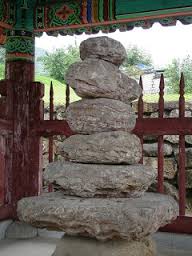
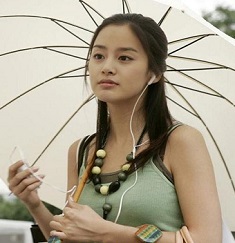


The Queen's(Heo Hwang-ok) DNA test results indicate that she is from south india and not from North.
ReplyDeletehttps://www.youtube.com/watch?v=4c4R_Hygvmk
https://www.youtube.com/watch?v=tvS3q785bq8
https://www.youtube.com/watch?v=XQLfV2fvgN4&t=661s
Uttar Pradesh state's emblem consist of a circular seal depicting the confluence of Ganga,
ReplyDeleteYamuna at Allahabad, a pair of fish to represent the former Muslim Nawabs of Oudh
and a bow and arrow to represent the Hindu deity Ram who was born in Ayodhy